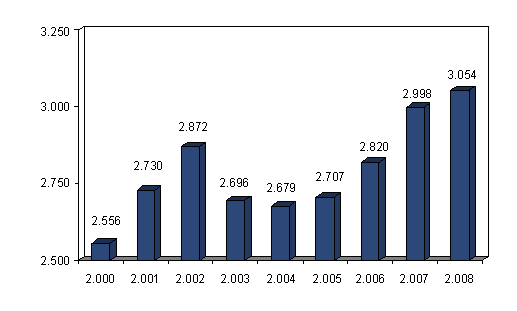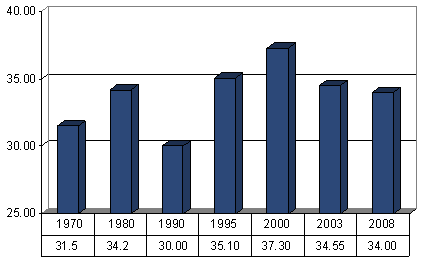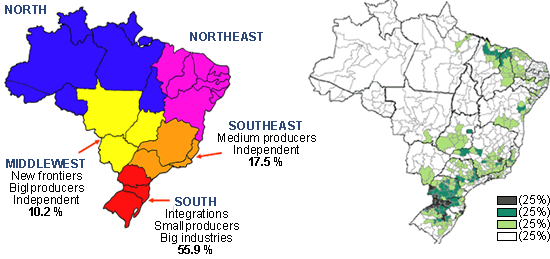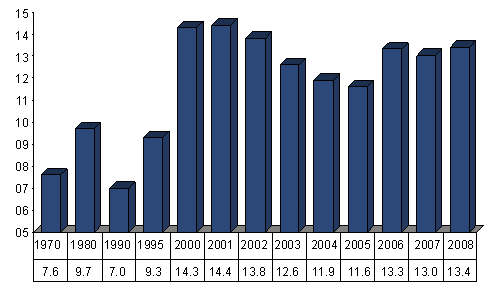Brazil is the world’s fourth biggest producer of pig meat, producing 3,054,000 tonnes in 2008. This represents 2.9% of the total world production. Graph 1 shows the evolution of pig meat production in Brazil in the period 2000 – 2008. Production increased from 2.55 million to 3.05 million with an average growth of 2.45% per year. The decrease in production in 2003 and 2004 was related to the important crisis in prices in 2002, when 3,600,000 pigs were slaughtered.
Graph 1 – Production of pig meat in Brazil, (millions of tonnes)

Brazil: evolution of pig livestock
There are currently 34 million head of Brazilian pigs and it is estimated that approximately 400,000 people directly depend on this activity / approximately 400,000 people work within the swine sector. In 1970, from 31.5 million head, 705,000 tonnes of meat was produced. In 2008, the production had increased to 3,054,000 tonnes from 34 million head. So, in 38 years the pig population increased by only 7.9% whereas the production of pig meat increased by 433%. The following figures (Graph 2) clearly show the technological development of the sector in this period, thanks to the constant effort of technicians and breeders in the areas of genetics, nutrition and management.
Graph 2 – Evolution of the Brazilian pig population (in millions of head)

Brazil: swine production according to region
The south region produces 55.9% of Brazilian swine. In this region the integration system is widely used and the heavy agro-industrial park is established. The southeast region has the most independent producers and is responsable for 17.5% of production. The middlewest region continues to develop and is responsable for 10.2% of production. It has been called “the new frontier” because new areas of Brazilian agro-business such as the production of corn, soya, pigs and poultry are beginning to grow. Graph 3 shows the five geographic regions of Brazil with their predominant type of swine production (on the left) and the density of pigs (on the right).
Graph 3 – Brazilian regions, type of swine production and density of pigs, 2008.

Brazil: sow livestock
The Brazilian sow population is currently at 2.3 million head, but only 1.48 million are considered as “technical production” (Table 1). The other 820,000 sows, mainly from local breeders, are considered as “backyard production” and they are found mainly in the northern area of the country. The total sow population was 19.5% greater in 2002 (2.86 million head) and the reduction was due to the great price crisis suffered by the sector. This big reduction occurred in the middlewest region where the system of independent producers still dominates. The best estimates on the effect of the price crisis suggest that approximately 360,000 sows were withdrawn from the chain of commercialization in 2002 and 2003. It will be considered as the greatest ever reduction in Brazilian swine production.
Table 1 – Evolution of sow population, 2002 – 2008 (millions of head)
| 2002 | 2008 | Difference, % | |
| Total sow population | 2.86 | 2.30 | - 19.5 |
| Technical production | 1.60 | 1.48 | - 7.2 |
| Naturally bred | 1.26 | 0.82 | - 35.1 |
| Piglets/sow/year | 18.2 | 22.0 | + 20.8 |
Brazil: consumption of pig meat
Pig meat is the most consumed meat in the world, but not in Brazil where beef and chicken are more popular. In Table 2 we can see that meat consumption per person in Brazil is approximately 86 kg a year which is more than double the world average.
Table 2 – Differences between Brazilian and worldwide meat consumption, 2008 (kg/person)
| World | Brazil | |
| Pig | 15.9 kg (40.0%) | 13.4 kg (16.0%) |
| Poultry | 13.4 kg (33.9%) | 37.0 kg (43.0%) |
| Beef | 10.3 kg (26.1%) | 35.6 kg (41.0%) |
In 2008, Brazilians only consumed an average of 13.4 kg of pig meat (Graph 4). This is the third highest result of the decade, but it is still 1 kg below the record high obtained in 2001. The reasons for this low consumption are related to economic conditions (poultry meat is cheaper) and cultural aspects (part of the population believes that eating pig meat leads to certain illnesses).The two main pig producer associations (ABCS and ABIPECS) are currently making important campaigns to promote the consumption of pig meat in Brazil, and their aim is to increase consumption to 15 kg in 2015.
Graph 4 – Basic consumption of pig in Brazil (kg/inhabitant/year)

Approximately 65% of pig consumed in Brazil is industrialized and only 35% is from cuts of fresh meat. The high costs of the industrial products hinders consumption during periods of economic restrictions and is one of the main causes of the low consumption in comparison with poultry meat. If we look at the evolution of meat consumption from 2000 to 2008 (Table 3), we will see that consumption of poultry meat rose by 23.7% and is currently the most consumed meat in Brazil. Beef lost its position as the most popular meat in this period and its growth was of only 4.1% In the same period consumption of pig meat fell by 6.3%.
Table 3 – Evolution of meat consumption in Brazil, 2000 – 2008 (kg/person)
| 2000 | 2008 | % | |
| Pig | 14.3 kg | 13.4 kg | - 6.3 |
| Poultry | 29.9 kg |
37.0 kg | + 23.7 |
| Beef | 34.2 kg | 35.6 kg | + 4.1 |
Brazil: the challenge of domestic consumption
There is great potential for increasing Brazilian swine production in the domestic market. With a population of 190 million inhabitants with the prediction to reach more than 200 million in 2015, any increase in consumption could represent a great challenge for production. Table 4 offers an example of what this increase could mean, taking into account two situations: the first with the consumption remaining at exactly the same level as today (13.4 kg/inhabitant). In this case, in 2015, with a population of 201 million, we would have to produce 154,000 tonnes of pig more. For this, 85,000 sows would need to be added to the current population, taking into account that every breeder would have to produce 1.8 tonnes of pig per year.
In the second hypothesis, which we could call “challenge”, we show what would need to be produced in 2015 if the consumption per capita reached 16 kg. In this case the production would need to grow by 0.678 million tonnes, and for this the population would need to increase by 376,000 sows. All of this growth is only based on the increase in domestic consumption, supposing that exports stayed at the current levels (529,000 tonnes).
Table 4 – Brazil: prospects for production increase related to domestic consumption increase
| Population | 13.4 kg (stable) | 16.0 kg (challenge) | |
| 2008 | 190.0 | 2.546 | |
| 2015 | 201.5 * | 2.700 | 3.224 |
| Production increase, milliones tonnes | 0.154 | 0.678 | |
| Necessary increase of sows** | 85.5 | 376.6 | |
(**)1 female x 24 pigs/year x 75 kg body = 1.8 tonnes/year





